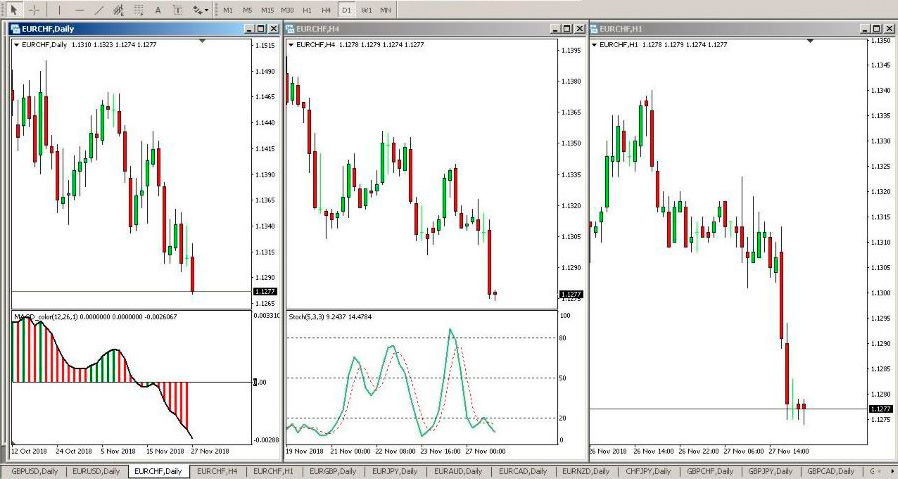As a rule, it is very difficult to analyze the market using just one indicator. However, there are many facts when different indicators used simultaneously give conflicting signals to start trading.
The “Elder’s three screens” strategy is applicable not only as an auxiliary filter that determines the trend, but also as a separate trading concept. This method is relevant in all markets and trading sessions. Elder’s trading strategy is a comprehensive approach to applying the three charts of the asset selected for trading with different time frames.
Method Features
The method is based on filtering trading operations by the largest time interval and identifying the correct entries by the smaller. This approach helps a trader to achieve a large profit with the least risk. The “three screens of Elder” system combines trend indicators and opposite oscillators. It is this set of tools that makes it possible to successfully filter disadvantageous transactions.
The founder of the Three Screen trading strategy compared the forex market with the ocean, which waves form the tides (uptrend) and low tides (downtrend). The period of prevalence of the uptrend in the market is the time of purchase of the asset. When the downtrend dominates, this is the time of sales. A peculiar market “calm” is a flat price movement. In such a period, it is better to refrain from trading.
The first screen should display all of the above market conditions. The second screen serves to determine the initial wave motion in the current trend. In other words, this is the determination of the moment when the correction ends and the next trend movement begins.
The third screen is used by the trader to accurately enter the transaction with setting the minimum safety stop loss.
Timeframe Selection
What is the optimal time period to choose for trading? The Three Screens trading strategy is universal - the timeframe should be determined depending on the trading style. The main thing is that the time interval of each subsequent chart should be five times less than the previous one.

The graph in the center is the main one. For long-term trading it is D1. It will display the price movement in this time interval. On the screen on the left there is the price movement with the time frame W1, on the right - H4. The monthly number of open transactions is no more than 3. However, the profit received is to be expected very significant.
Traders who prefer medium-term trading should analyze the screens displaying the asset’s price on H4, H1, M15 screens. In this case, the number of transactions will be much larger, which can increase profits several times. But this also increases the number of false signals to enter the market.
Scalping enthusiasts should choose M30, M5, M1 timeframes for this strategy. The above set of intervals is advisory. If desired, using personal trading experience, each trader can choose other timeframes for himself.
The essence of the strategy of Alexander Elder’s "Three screens"
This trading method provides for the initial determination of the direction of price movement on the first screen with the highest timeframe. The indicators set here serve as a filter, giving initial signals for transactions. As an indicator, MACD with average settings is used. The decline in its columns determines the downward trend, especially when the MACD crosses the zero mark from top to bottom. Rising bars indicate the presence of an uptrend, in particular, when the histogram crosses the zero mark from bottom to top.

The strength of the trend is determined by the angle of the histogram to the zero mark - the larger it is, the faster the trend is growing (decreasing), and the greater the profit margin. From time to time, MACD may give false signals to enter the market. To minimize them, an additional filter is effectively applied - EMA 13:
- When the price of an asset is above this moving average, the trader should focus on purchases;
- If price movement occurs below the EMA, only sales should be considered;
- When moving sideways, it is wiser to refrain from all transactions.
It happens that conflicting signals come from MACD and EMA 13. Then moving average signals are considered more priority. However, it is better to wait until the signals of these indicators coincide.
The second screen in the Alexander Elder’s trading system serves to monitor the end of the trend correction on a smaller timeframe. This occurs after the identification of the main trend movement in an older time interval. Therefore, using the second screen, a trader who has decided on purchases (sales) is looking for a moment for optimal entry into the transaction by setting a safety stop loss at a minimum. It is for this timeframe that a stochastic oscillator is installed.
If you are looking for a favorable moment for purchases, you should wait until the "stochastic" leaves the oversold zone.

When selling, you should wait for the oscillator to exit the overbought zone. Beginner traders can very well use two screens for transactions. The third screen usually suits experienced traders. On it, traders determine an even more accurate moment of opening orders. Indicators are not required here. In this case, the shifted purchase or sale method is rational.
Its essence can be considered with a specific example. After analyzing the market situation on the higher timeframes, the trader concludes that there is an increasing trend, and the "stochastic" has already left the oversold zone. Then on the third screen you should set the pending Buy Stop slightly higher than the maximum of the previous candle.

If it does not work, you need to move it to the next maximum of the newly closed candle. This procedure can be repeated until the order is triggered. As soon as this happens, set your stop loss just below the low of the last two bars.
In the case of sales, everything happens exactly the opposite. A Sell Stop order is similarly moved until it becomes active, after which a safety stop loss is immediately set.
The amount of profit from transactions is calculated in several ways. One of the most popular is when the distance between the open price and stop loss multiplied by 3 is measured on the chart of the asset from its current price. Thus, goals are three times higher than possible losses. After about half the price traveled to the target, the safety order is transferred to breakeven. Some traders use a trailing stop for this.
Among others, there is another option for fixing profit using the Stochastic Oscillator. Orders are closed at the moment the “stochastic” leaves the overbought or oversold zone on the second screen.
A number of traders who prefer long-term trading close profitable transactions, focusing on the first screen. This happens immediately after the opposite signal has formed. Although the number of successful trading operations is reduced, the profit is a pleasant surprise for traders.
Conclusion
The trading strategy “Three screens of Elder” has a minimum risk level with a rather high profitability. For many years, this trading method has retained its popularity. It is tested by time, because it complies with the main rule of the foreign exchange market - following the trend.
















